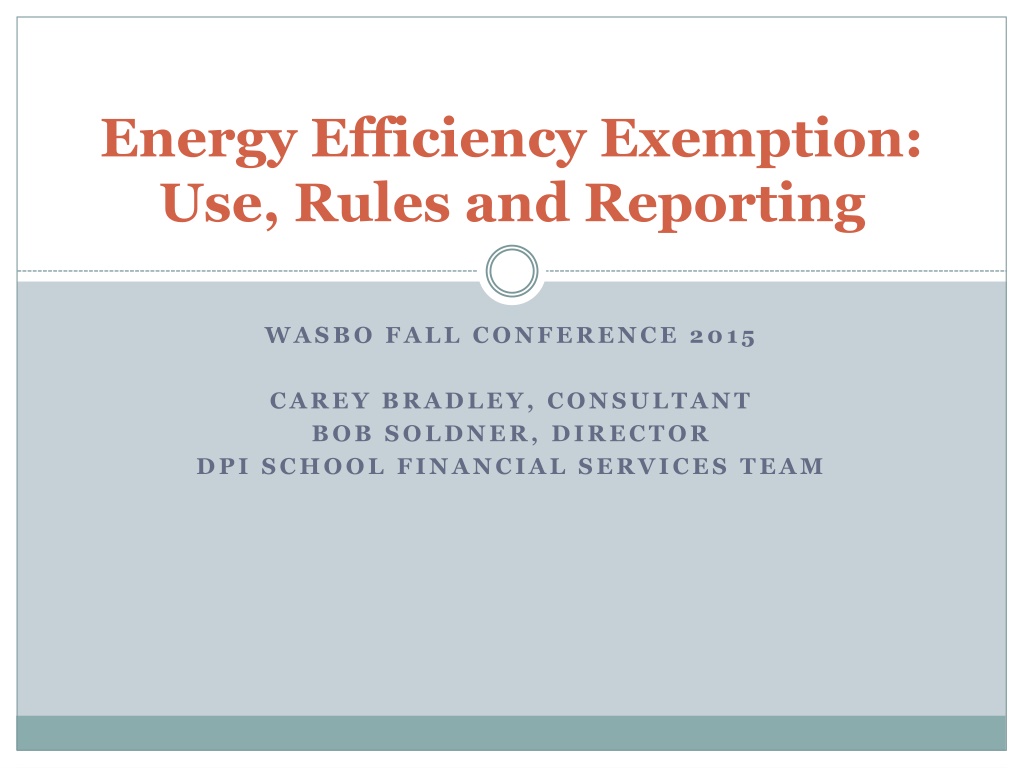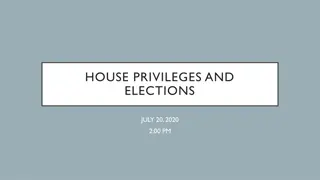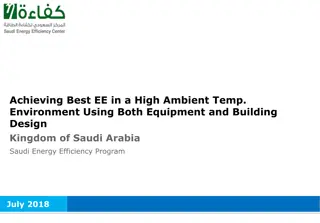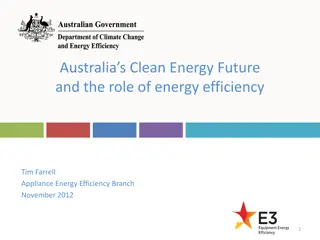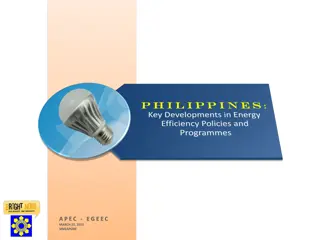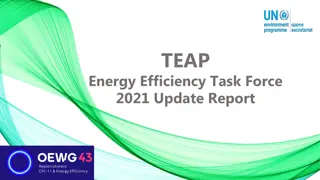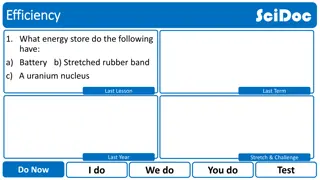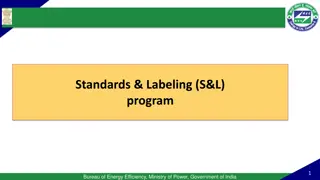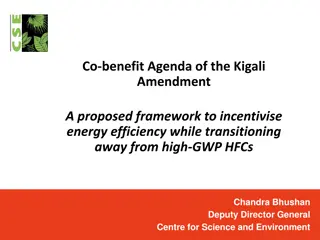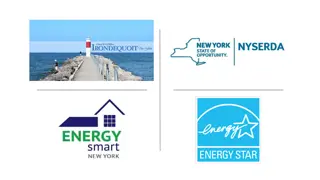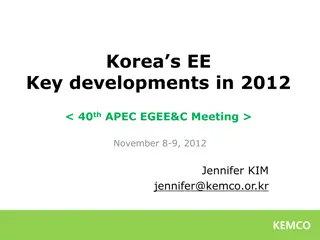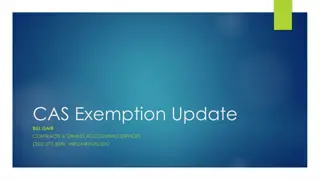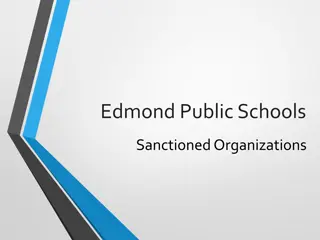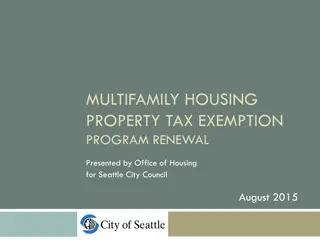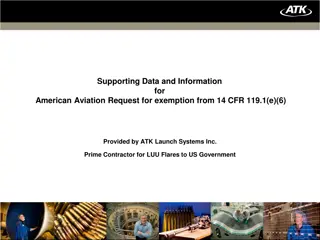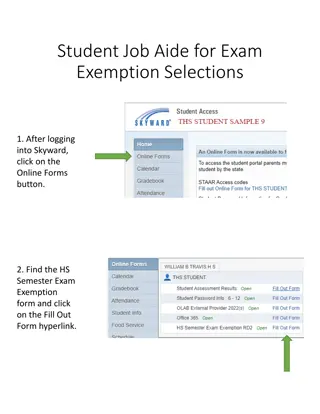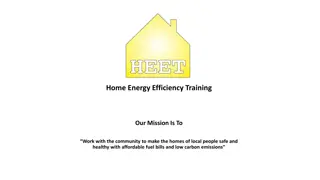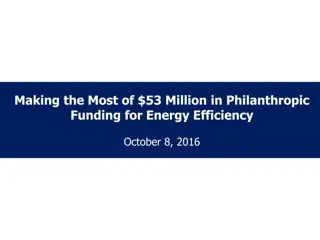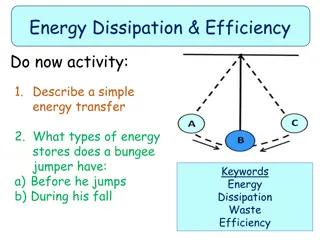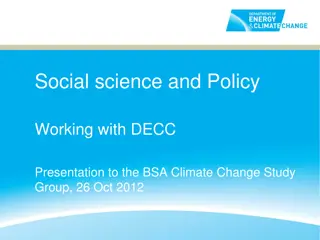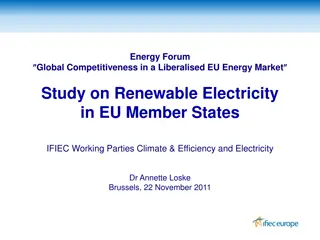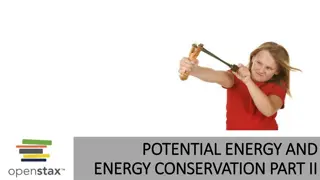Energy Efficiency Exemption: Rules and Research Considerations
Explore the guidelines and requirements for implementing energy efficiency projects under an exemption to the revenue limit in school districts. Learn about due diligence, cost-saving analysis, and the importance of performance contracts to ensure sustainable savings over time.
Download Presentation

Please find below an Image/Link to download the presentation.
The content on the website is provided AS IS for your information and personal use only. It may not be sold, licensed, or shared on other websites without obtaining consent from the author. Download presentation by click this link. If you encounter any issues during the download, it is possible that the publisher has removed the file from their server.
E N D
Presentation Transcript
Energy Efficiency Exemption: Use, Rules and Reporting WASBO FALL CONFERENCE 2015 CAREY BRADLEY, CONSULTANT BOB SOLDNER, DIRECTOR DPI SCHOOL FINANCIAL SERVICES TEAM
USE RESEARCH AND DUE DILIGENCE SCHOOL BOARD CONSIDERATION AND RESOLUTION
Research and Due Diligence Energy Efficiency Exemption to the Revenue Limit Under 121.91 (4) (o) a school board may adopt a resolution to increase the revenue limit otherwise applicable to a school district in any school year by an amount spent by the school district in that school year on either a project to implement energy efficiency measures, or to purchase energy efficiency products. However, certain conditions must first be met.
Research and Due Diligence A properly executed performance contract entered into under 66.0133. (Required for the resolution.) The performance contract provides the board with cost and savings information regarding the energy efficiency measures and products. The board completes a cost/savings analysis to identify the period of time required for the entire project s savings to equal costs and whether the amount the school board will spend on the project is not likely to exceed the savings over the useful life of the facility.
Research and Due Diligence The project improves the energy efficiency of existing facilities or equipment. The energy efficiency measures or products result in the avoidance of, or reduction in, energy (utility) costs or operational costs. The energy efficiency related expenditures result in future utility or operational savings sufficient to cover the costs over a period of time (not greater than the useful life of the facility) as identified by the board of education. (Project cost/ savings analysis).
Research and Due Diligence A plain language reading of the literature regarding performance contracting for energy efficiency projects might lead the average person to the conclusion that the identified savings resulting from the completion of the project will be sufficient to pay for the costs of the project over the life of the debt. In essence, the project will pay for itself and maybe even save more money after the debt is paid off. $1,000,000 project with 10 year debt term and payback results in annual payment and expected savings of $100,000 per year. 66.0133allows for a much broader application. Energy and operational savings are identified, using a variety of measures, to offset costs. Per 66.0133(2)(c), the school board must determine that the amount it will spend on the project is not likely to exceed the savings over the useful life of the facility (not the term of the debt).
Research and Due Diligence Information about the project (included in resolution) Name of School District Name of Qualified Contractor Contract Length (years) Total Project Cost* Total Project Payback Period Years of Debt Payments Remaining Useful Life of the Facility
Research and Due Diligence SUMMARY COST /SAVING ANALASIS PAYBACK PERIOD (YEARS) PROJECT EXPENDITURES PROJECT COST SAVINGS Specific Energy Efficiency Measure or Products Total Project Cost Including Financing Total Annual Utility Cost Savings Total Annual Non- Utility Cost Savings Cost/Savings One-time Savings $ # $ $ $ List individual projects Project Totals for performance contract entered into per 66.0133
Research and Due Diligence COST SAVINGS(RECOVERY) PERFORMANCE INDICATORS AND MEASURES UTILITY SAVINGS FROM ELECTRICITY, HEATING,WATER Specific Energy Efficiency Measure or Products Unit Savings Measurement Units Cost per Unit Cost Savings List individual projects kWh, Kw,Therm, BTU, Gallon, Cubit feet # $ $ Project Totals for performance contract entered into per 66.0133 $
Research and Due Diligence COST SAVINGS(RECOVERY) PERFORMANCE INDICATORS AND MEASURES NON-UTILITY SAVINGS OPERATIONAL, CAPITAL COST AVOIDANCE, AND ONE-TIME Specific Energy Efficiency Measure or Products Description Cost Savings List individual projects $ Project Totals for performance contract entered into per 66.0133 $
School Board Consideration and Resolution Is the information contained in the contract sufficient to meet the PI 15 resolution requirements? See: PI 15 Appendix A, Sample Resolution and Cost/Savings Data Table http://sfs.dpi.wi.gov/sfs_enrgyrevlim Confirm energy savings exist for each of the projects included in the performance contract. Savings should be reported in the appropriate unit of measure.
School Board Consideration and Resolution The project may be financed with current year funds or debt. A resolution is limited to either current year funds or debt. If both types of funding are chosen, separate resolutions are required. A bond, note, or state trust fund loan obtained to finance the project is issued for a term not exceeding 20 years. If debt is issued, the resolution is valid for the term of the debt and should include all of the years in which the exemption applies. The Board may amend or pass a new resolution to reflect desired changes in the exemption expense. Utility savings related to the project will continue to be applied to reduce debt as long as there is an exemption expense for the project.
School Board Consideration and Resolution When the exemption is used for debt payments, state law requires the related utility savings be used to retire the bond, note, or state trust fund loan. The Department of Public Instruction will accomplish this by annually reducing the exemption for energy efficiency expenditures by the reported utility savings.
RULES ADMINISTRATIVE RULE PI 15
Administrative Rules Under Wis. Stat. 227.01 (13), an administrative rule is defined as "a regulation, standard, statement of policy, or general order of general application which has the effect of law and which is issued by an agency to implement, interpret, or make specific legislation enforced or administered by the agency or to govern the organization or procedure of the agency. Administrative rules have the force of law.
Emergency Rule Revising PI 15 Relating to Revenue Limit Exemptions for Energy Efficiencies. This rule change modifies PI 15 to reflect changes in the corresponding statutes as a result of 2011 Wisconsin Act 32 and 2013 Wisconsin Act 20. The emergency rule is effective from September 12, 2015 until February 8, 2016.
Emergency Rule An Emergency Rule was put in place to establish the processes necessary for school boards and the electorate to properly approve the 2015-16 budget and set the Fall 2015 property tax levy. All resolutions passed after September 12, 2015 must meet the requirements of the Emergency Rule. The SAFR Reporting has been updated to accommodate related changes in the law.
Emergency Rule Things to know if you already have a contract or used the exemption in the past: Resolutions passed after September 12, 2015. 1. May include the annual exemption amounts for the term of the debt. (Only pass a resolution once.) 2. Report only the utility savings to DPI, but continue to report the annual energy and operational savings to the electorate along with the budget. 3. May not include expenses for one-to-one instructional devices. Unexpended funds are no longer a base revenue limit reduction penalty. Utility savings are reported separately and should not be used to reduce the expense amount in your resolution.
Permanent Rule 1) Statements of Scope The first step in the rulemaking process is preparation of a scope statement that sets forth information about the agency s intended rulemaking, including the objective of the proposed rule, the statutory authority for the rule, and a description of all entities that may be affected by the rule. The statement is published in the Administrative Register. http://docs.legis.wisconsin.gov/code/scope_statemen ts/055_15
Permanent Rule 2) Proposed Rules Submitted to Rules Clearinghouse http://docs.legis.wisconsin.gov/code/chr/all/cr_15_0 72 3) Agency Hearing After an emergency rule is published, a public hearing must be held. After a permanent rule is submitted to the Rules Clearinghouse for review, DPI holds a public hearing before the rule is submitted to the Legislature unless the rule changes are technical changes.
Permanent Rule 4) Rules Submitted to Legislature. Once a public hearing is held or if no public hearing is required, a permanent rule can be submitted to the Legislature for either passive review or legislative action if any of the standing committees object to the rule. Emergency rules are not required to be submitted to the Legislature. Under Wis. Stat. 227.19 (2), a rule is referred to one standing committee in each house before being submitted to the Joint Committee for Review of Administrative Rules.
Permanent Rule 5) Final Rules. After legislative review, the final stage of the rulemaking process is filing the rule. The Rules Promulgation process may be followed on the Policy and Budget Team s webpage: http://pb.dpi.wi.gov/
REPORTING REPORTING AT THE BUDGET HEARING (65.90) REPORTING TO DPI REVENUE LIMIT WORKSHEET
Reporting to The Public Annually complete and publish the 65.90 Addendum reporting project savings for utility and operational costs to the public at the Budget Hearing. REMEMBER: You are reporting the resolution and the results related to the project expenditures in the resolution.
Reporting to DPI in SAFR* Resolution Project Information including cost/savings analysis for each energy efficiency measure or product included in the project as well as the project total. Exemption (expense and levy) amount determined by the Board Utility savings are reported annually or when known *School Finance Reporting Portal: http://sfs.dpi.wi.gov/sfs_safrlinks
Revenue Limit Worksheet Line 10.c. is calculated based on reported data Data is pulled from PI-1506 AC SAFR Referendum Reporting Review your data
Revenue Limit Worksheet Adjustment for single year projects If this is debt expense, it will be adjusted next year
RESOURCES Sample Resolution Data table to collect information for the resolution Guidance Document SAFR Reporting Directions Borrowing Authority ($1,ooo,ooo) Contact: Carey Bradley, DPI School Finance Consultant carey.bradley@dpi.wi.gov or 608-267-3752
